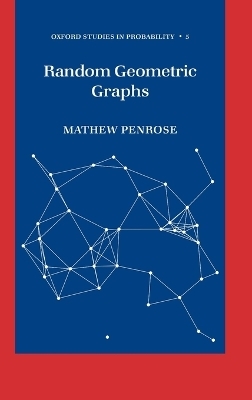
Random Geometric Graphs
Seiten
2003
Oxford University Press (Verlag)
978-0-19-850626-3 (ISBN)
Oxford University Press (Verlag)
978-0-19-850626-3 (ISBN)
This monograph provides and explains the probability theory of geometric graphs. Applications of the theory include communications networks, classification, spatial statistics, epidemiology, astrophysics and neural networks.
This monograph sets out a body of mathematical theory for finite graphs with nodes placed randomly in Euclidean space and edges added to connect points that are close to each other. As an alternative to classical random graph models, these geometric graphs are relevant to the modelling of real-world networks having spatial content, arising in numerous applications such as wireless communications, parallel processing, classification, epidemiology, astronomy, and the internet.
Aimed at graduate students and researchers in probability, combinatorics, statistics, and theoretical computer science, it covers topics such as edge and component counts, vertex degrees, cliques, colourings, connectivity, giant component phenomena, vertex ordering and partitioning problems. It also illustrates and extends the application to geometric probability of modern techniques including Stein's method, martingale methods and continuum percolation.
This monograph sets out a body of mathematical theory for finite graphs with nodes placed randomly in Euclidean space and edges added to connect points that are close to each other. As an alternative to classical random graph models, these geometric graphs are relevant to the modelling of real-world networks having spatial content, arising in numerous applications such as wireless communications, parallel processing, classification, epidemiology, astronomy, and the internet.
Aimed at graduate students and researchers in probability, combinatorics, statistics, and theoretical computer science, it covers topics such as edge and component counts, vertex degrees, cliques, colourings, connectivity, giant component phenomena, vertex ordering and partitioning problems. It also illustrates and extends the application to geometric probability of modern techniques including Stein's method, martingale methods and continuum percolation.
1. Introduction ; 2. Probabilistic ingredients ; 3. Subgraph and component counts ; 4. Typical vertex degrees ; 5. Geometrical ingredients ; 6. Maximum degree, cliques and colourings ; 7. Minimum degree: laws of large numbers ; 8. Minimum degree: convergence in distribution ; 9. Percolative ingredients ; 10. Percolation and the largest component ; 11. The largest component for a binomial process ; 12. Ordering and partitioning problems ; 13. Connectivity and the number of components ; References ; Index
| Erscheint lt. Verlag | 1.5.2003 |
|---|---|
| Reihe/Serie | Oxford Studies in Probability ; 5 |
| Zusatzinfo | numerous figures |
| Verlagsort | Oxford |
| Sprache | englisch |
| Maße | 162 x 241 mm |
| Gewicht | 649 g |
| Themenwelt | Informatik ► Theorie / Studium ► Künstliche Intelligenz / Robotik |
| Mathematik / Informatik ► Mathematik ► Geometrie / Topologie | |
| Mathematik / Informatik ► Mathematik ► Graphentheorie | |
| ISBN-10 | 0-19-850626-0 / 0198506260 |
| ISBN-13 | 978-0-19-850626-3 / 9780198506263 |
| Zustand | Neuware |
| Haben Sie eine Frage zum Produkt? |
Mehr entdecken
aus dem Bereich
aus dem Bereich
Buch | Softcover (2024)
REDLINE (Verlag)
CHF 27,95
Eine kurze Geschichte der Informationsnetzwerke von der Steinzeit bis …
Buch | Hardcover (2024)
Penguin (Verlag)
CHF 39,20


